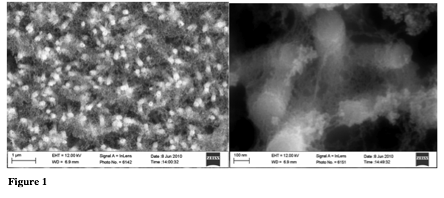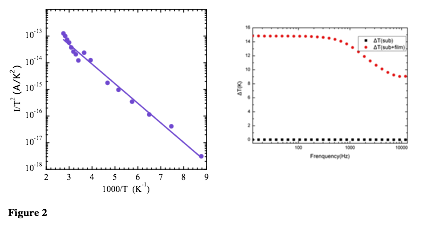www.acsprf.org
Reports: ND1049889-ND10: Phonon Depletion-Based Nanostructured Thermoelectric Energy Generation
Bruce White, PhD , State University of New York at Binghamton
Introduction
The New Directions grant from the Petroleum Research Fund has greatly benefitted my transition from a leadership position in a semiconductor industry research and development environment to that of a professor and research scientist in an academic setting.
| Figure 1
|
 With the
funds provided by PRF, one graduate student and two undergraduate students have
been supported. These students have
focused on developing phonon scattering based approaches to realizing improved
efficiency thermoelectric materials.
With the
funds provided by PRF, one graduate student and two undergraduate students have
been supported. These students have
focused on developing phonon scattering based approaches to realizing improved
efficiency thermoelectric materials.The PRF funds have provided seed funding that has led to one $250000 grant from the New York State Energy Research and Development Authority and 475000 service units (valued by NSF at $1/service unit) for molecular dynamics simulations of heat flow in these nanostructured materials. The funds have also partially supported a graduate student and undergraduate student to present their research results at national conferences.
From a research perspective, the focus of this award is to explore opportunities for using controlled phonon scattering in nanocomposite materials to create sustainable and efficient thermoelectric materials. Two classes of materials are being explored. One, a nanocomposite material formed from a nanowire embedded in a strong phonon scattering medium. The nanowire is formed from a material with large Seebeck coefficient and excellent electrical conductivity while the phonon scattering medium is formed from a material that has both a high phonon density of states as well as a low lattice thermal conductivity. The second material being explored is that of a material in which 20% of the lattice planes have their mass artificially increased. These "heavy" lattice planes are being explored to understand the conditions under which Anderson localization of the phonons occurs. Anderson localized phonons are interesting for thermoelectric materials in that these phonons, ideally, have zero lattice thermal conductivity.
Experimental Formation and Characterization of ZnO Nanowire/Aerogel Composites
ZnO is a material that in bulk form has large a Seebeck coefficient (500μV/K) but with a lattice thermal conductivity too large for efficient energy generation. In this experimental work, thin ZnO nanowires are formed using solution-based processes. A solution of TEOS and water is spin-coated onto the ZnO nanowire containing substrate, followed by ethanol- water exchanges in this thin sol-gel film. The material is then supercritically dried in CO2 to produce the desried nanocomposite. SEM cross-sections of both the ZnO nanowires and the ZnO nanowires embedded in aerogel are shown in figure 1.
| Figure 2
|

To electrically characterize the nanocomposites, patterned Cr electrodes were deposited in such a way as to form a continuous electrode structure in contact with the porous nanocomposite layer. Current-Voltage curves as a function of temperature are shown in figure 2 (left). The data indicate that the predominant conduction mechanism in the nanocomposite is one based on Schottky emission, with an effective barrier height of 0.5eV . The fact that current injection into the nanocomposite material is the rate limiting step for conduction suggests that scattering processes within the nanocomposite are relatively small in these structures, which bodes well for thermoelectric performance.
The well known three-omega technique was used to determine the thermal conductivity of the samples. In figure 2 (right), the three-omega temperature as a function of excitation frequency is shown at room temperature (292 ûK). Two sets of data are shown, one the frequency response of the surface temperature of a bare silicon wafer and the other the frequency response of a bare silicon wafer on which the nanocomposite has been grown. Data for the nanocomposite material indicate a thermal conductivity of 50mW/m-K indicating that a thermoelectric figure of merit of approximately three is possible with this material if the Seebeck coefficient remains similar to bulk ZnO. Measurements of the Seebeck coefficient are now underway.
Molecular dynamics simulations of heat flow in nanocomposite thermoelectric materials.
Reverse non-equilibrium molecular dynamics techniques are utilized to determine the efficacy of nanocomposites in reducing lattice thermal conductivity. Three different systems have been explored: A solid in which entire planes of atoms are randomly selected to have their mass increased, a solid in which the same heavy atoms are randomly distributed throughout the lattice, and a pure LJ solid with no mass disorder. The simulated thermal conductivities of these solids are
| Figure 3
|
 shown in
figures 3.
shown in
figures 3.The thermal conductivity results for the pure LJ solid (Argon) show a decreasing thermal conductivity with increasing temperature, as expected. The simulated results are in excellent agreement with theoretical calculations. The addition of 1% random mass disorder to the solid causes a small reduction in the thermal conductivity due to increased Rayleigh scattering of the phonons and a small reduction in the phonon group velocity due to an increased average mass. As the percentage of random mass disorder increases the thermal conductivity continues to be reduced due to increased Rayleigh scattering, ultimately producing a temperature independent thermal conductivity when the amount of disorder reaches 20%.
These results should be contrasted with the results produced when entire planes of atoms, randomly selected, have their mass increased. In this case, increasing the mass of 1% of the atoms produces a thermal conductivity similar to the case of the 20% random mass disorder solid. As the percentage of mass increased planes (or atoms) approaches 5%,10%, and 20%, the thermal conductivity continues to be reduced. Moreover, the temperature dependence of the thermal conductivity changes to one that tends to increase with increasing temperature. We attribute this reduced thermal conductivity to Anderson Localization of the phonons in these solids with the temperature dependence of the thermal conductivity being explained by increased localized mode coupling due to an increasingly anharmonic potential at higher temperatures. This behavior is very similar to that seen in structurally amorphous solids. The overall reduction in the lattice thermal conductivity in these systems approaches a factor of thirty compared to the pure Argon solid at 20K. This bodes well for providing a mechanism for significantly reducing the lattice thermal conductivity in thermoelectric materials. Opportunities for reducing the lattice thermal conductivity of silicon, a sustainable material with very large Seebeck coefficient, are now being explored.
